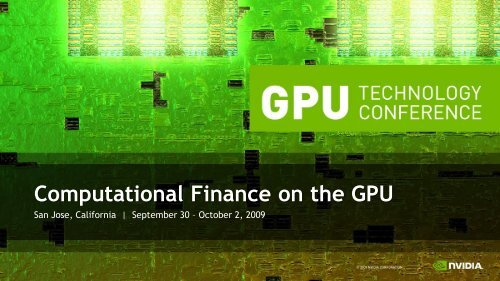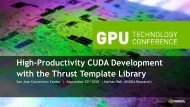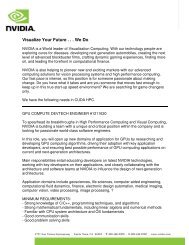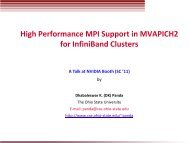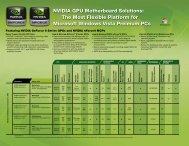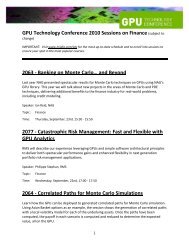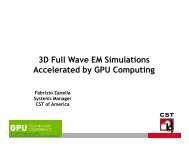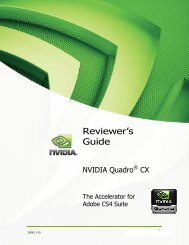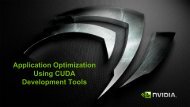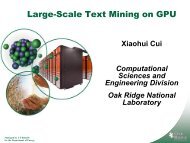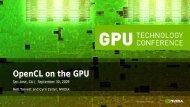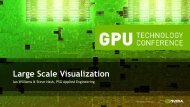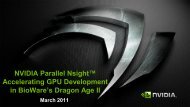Computational Finance on the GPU
Computational Finance on the GPU
Computational Finance on the GPU
You also want an ePaper? Increase the reach of your titles
YUMPU automatically turns print PDFs into web optimized ePapers that Google loves.
<str<strong>on</strong>g>Computati<strong>on</strong>al</str<strong>on</strong>g> <str<strong>on</strong>g>Finance</str<strong>on</strong>g> <strong>on</strong> <strong>the</strong> <strong>GPU</strong><br />
San Jose, California | September 30 – October 2, 2009
Objective<br />
• Develop understanding of what<br />
“<str<strong>on</strong>g>Computati<strong>on</strong>al</str<strong>on</strong>g> <str<strong>on</strong>g>Finance</str<strong>on</strong>g>” means<br />
• Learn who uses <str<strong>on</strong>g>Computati<strong>on</strong>al</str<strong>on</strong>g> <str<strong>on</strong>g>Finance</str<strong>on</strong>g><br />
– Why do <strong>the</strong> users need it?<br />
– What do <strong>the</strong>y do with <strong>the</strong> informati<strong>on</strong>?<br />
• Take a look at some typical algorithms<br />
• C<strong>on</strong>sider <strong>the</strong> challenges and benefits of adopti<strong>on</strong>
AGENDA<br />
Financial Instruments<br />
Who’s Who<br />
Modeling<br />
Algorithms<br />
Adopti<strong>on</strong><br />
Summary
AGENDA<br />
Financial Instruments<br />
Who’s Who<br />
Modeling<br />
Algorithms<br />
Adopti<strong>on</strong><br />
Summary
Financial Instruments<br />
Cash Instruments<br />
Equities<br />
Commodities<br />
Fixed Income<br />
Foreign Exchange<br />
Derivatives<br />
Exchange-traded<br />
Over-<strong>the</strong>-counter
Equities<br />
• Share ownership<br />
• Value determined<br />
by market<br />
• Dividends
Commodities<br />
• Raw resource<br />
– Agriculture: corn, rice<br />
– Livestock: pork bellies<br />
– Energy: oil, gas<br />
– Metals: precious, industrial<br />
• Supply and demand
Fixed Income<br />
• Also: Credit<br />
• Loans and b<strong>on</strong>ds<br />
• Different rates<br />
according to durati<strong>on</strong>
Foreign Exchange<br />
• Also: Forex or FX<br />
• Take advantage of<br />
changes in rates
Derivatives<br />
• Based <strong>on</strong> <strong>on</strong>e or more underlying assets<br />
– Equities, FX, credit<br />
• Many types of c<strong>on</strong>tract<br />
– Forwards and futures<br />
– Opti<strong>on</strong>s<br />
– Swaps<br />
• Exchange-traded or Over-<strong>the</strong>-Counter (OTC)
Example: Opti<strong>on</strong>s<br />
• Holder has <strong>the</strong> right to<br />
buy (call) or sell (put)<br />
<strong>the</strong> underlying asset<br />
– By a certain date<br />
– At a certain price<br />
Payoff put<br />
where<br />
K<br />
S<br />
max( K<br />
strike<br />
spot<br />
price<br />
price<br />
S,<br />
0)<br />
Profit ($)<br />
2500<br />
2000<br />
1500<br />
1000<br />
500<br />
0<br />
-500<br />
0 10 20 30 40 50 60<br />
Stock price ($)
AGENDA<br />
Financial Instruments<br />
Who’s Who<br />
Modeling<br />
Algorithms<br />
Adopti<strong>on</strong><br />
Summary
Traders<br />
• Trading:<br />
– Standardised instruments<br />
– New (often complex) instruments<br />
• Requires models:<br />
– Pricing<br />
– Predicti<strong>on</strong><br />
– Risk analysis Traders Backoffice Quants Developers
Backoffice<br />
• M<strong>on</strong>itoring <strong>the</strong> banks exposure<br />
• Model all trades<br />
– Value<br />
– Risk<br />
• Value-at-Risk (VaR) required for regulati<strong>on</strong><br />
Traders Backoffice Quants Developers
Quants<br />
• Develop and implement models for traders<br />
• Develop independent models for validati<strong>on</strong><br />
• Research<br />
• Modelling exposure and capital<br />
Traders Backoffice Quants Developers
Developers<br />
• Implement models from quants<br />
• Integrate into larger applicati<strong>on</strong>s<br />
– Interface to o<strong>the</strong>r models<br />
– Interface to database<br />
– Interface to user<br />
Traders Backoffice Quants Developers
AGENDA<br />
Financial Instruments<br />
Who’s Who<br />
Modeling<br />
Algorithms<br />
Adopti<strong>on</strong><br />
Summary
Inputs/Outputs<br />
Instrument<br />
parameters<br />
Market<br />
data<br />
Value<br />
C<strong>on</strong>fidence<br />
Sensitivities
Traders<br />
• Determine price for trade<br />
– Negotiate over <strong>the</strong> ph<strong>on</strong>e, require results fast<br />
– Minimize out-trades (errors)<br />
• Run positi<strong>on</strong>s<br />
– Sensitivities allow trader to predict resp<strong>on</strong>se to changes in<br />
underlying assets<br />
– Run often to allow trader to react quickly<br />
Traders Backoffice Quants Developers
Backoffice<br />
• Manage risk and capital reserves for regulati<strong>on</strong><br />
– Large runs can take days to complete<br />
– Accurate results allow greater c<strong>on</strong>trol, and hence more trades<br />
• M<strong>on</strong>itor traders’ exposure<br />
– Run intra-day<br />
• Greater accuracy requires l<strong>on</strong>ger run times<br />
Traders Backoffice Quants Developers
AGENDA<br />
Financial Instruments<br />
Who’s Who<br />
Modeling<br />
Algorithms<br />
Adopti<strong>on</strong><br />
Summary
Analytic<br />
• Some derivatives have an analytic soluti<strong>on</strong><br />
f<br />
t<br />
rS<br />
f<br />
S<br />
1<br />
2<br />
2 2<br />
S<br />
2<br />
f<br />
2<br />
S<br />
rf<br />
Black -Scholes<br />
Formula<br />
• Compare analytical result with numerical result<br />
– Provides a C<strong>on</strong>trol Variate<br />
f<br />
d<br />
d<br />
1<br />
2<br />
Ke<br />
rT<br />
ln( S<br />
0<br />
(<br />
K)<br />
d<br />
2<br />
)<br />
( r<br />
T<br />
d )<br />
2)<br />
T<br />
ln( S0<br />
K)<br />
( r<br />
T<br />
2<br />
2)<br />
T<br />
d1<br />
Price for European Put Opti<strong>on</strong><br />
S<br />
0<br />
2<br />
(<br />
1<br />
T
Binomial Trees<br />
• Represent possible paths of stock<br />
• Assumpti<strong>on</strong>s:<br />
– Stock has a probability p of moving up<br />
by a certain percentage u<br />
– Stock has a probability (1-p) of moving<br />
down by a certain percentage d
Binomial Trees<br />
• C<strong>on</strong>struct <strong>the</strong> tree<br />
– Create a branch for each<br />
time step<br />
– At each node <strong>the</strong> stock<br />
can ei<strong>the</strong>r go up u% or<br />
down d%
Binomial Trees
Binomial Trees <strong>on</strong> <strong>the</strong> <strong>GPU</strong><br />
• Work backwards in time<br />
– Compute value at each<br />
node<br />
• Partiti<strong>on</strong> <strong>the</strong> work across<br />
<strong>the</strong> SMs<br />
– Overlap input data<br />
– Fit input partiti<strong>on</strong> in<br />
smem
Finite Differences<br />
• Solve <strong>the</strong> Partial Differential Equati<strong>on</strong> iteratively<br />
– Divide <strong>the</strong> life of <strong>the</strong> derivative into equal intervals<br />
of length Δt<br />
– Divide <strong>the</strong> range of stock prices [0,S max] into equal<br />
intervals of size ΔS<br />
• Work backwards in time, compute <strong>the</strong> value at<br />
each node
Finite Differences - Implicit<br />
• Relati<strong>on</strong>ship:<br />
– Three values at t and <strong>on</strong>e<br />
value at t + Δt<br />
• Always c<strong>on</strong>verges to<br />
soluti<strong>on</strong><br />
• Requires solving<br />
simultaneous equati<strong>on</strong>s
Finite Differences - Explicit<br />
• Relati<strong>on</strong>ship:<br />
– One value at t and three<br />
values at t + Δt<br />
• Compute nodes in<br />
parallel<br />
• Can diverge from<br />
soluti<strong>on</strong>
Explicit Finite Differences <strong>on</strong> <strong>the</strong> <strong>GPU</strong><br />
• Partiti<strong>on</strong> <strong>the</strong> grid across<br />
<strong>the</strong> SMs
Explicit Finite Differences <strong>on</strong> <strong>the</strong> <strong>GPU</strong><br />
• Partiti<strong>on</strong> <strong>the</strong> grid across<br />
<strong>the</strong> SMs<br />
• Each SM requires a<br />
“halo”<br />
– Halo size determines how<br />
many time steps in batch
Explicit Finite Differences <strong>on</strong> <strong>the</strong> <strong>GPU</strong><br />
• Partiti<strong>on</strong> <strong>the</strong> grid across<br />
<strong>the</strong> SMs<br />
• Each SM requires a<br />
“halo”<br />
– Halo size determines how<br />
many time steps in batch<br />
– After each batch,<br />
distribute new halos
M<strong>on</strong>te Carlo<br />
• Sample a random walk for <strong>the</strong> asset(s)<br />
• Calculate <strong>the</strong> payoff of <strong>the</strong> derivative<br />
• Repeat to get many sample payoff values<br />
• Calculate <strong>the</strong> mean payoff
M<strong>on</strong>te Carlo<br />
Asset price ($)<br />
110<br />
108<br />
106<br />
104<br />
102<br />
100<br />
98<br />
96<br />
94<br />
92<br />
90<br />
0 T<br />
Time<br />
10<br />
8<br />
6<br />
4<br />
2<br />
0<br />
-2<br />
-4<br />
-6<br />
-8<br />
-10<br />
Payoff ($)<br />
Expected<br />
payoff
M<strong>on</strong>te Carlo <strong>on</strong> <strong>the</strong> <strong>GPU</strong><br />
Generate<br />
Random Numbers<br />
• Distributi<strong>on</strong><br />
• Covariance<br />
Compute payoff<br />
for each path<br />
• Scenarios are<br />
independent<br />
Compute<br />
statistics<br />
• Reducti<strong>on</strong>
M<strong>on</strong>te Carlo – Multiple Kernels<br />
RNG Paths Payoffs Reduce<br />
parfor [0..T)<br />
for [0..N)<br />
genrand()<br />
Samples<br />
parfor [0..N)<br />
for [0..T)<br />
genpath()<br />
Paths<br />
parfor [0..N)<br />
payoff()<br />
Payoffs<br />
for [0..lg 2N)<br />
reduce()
M<strong>on</strong>te Carlo – Single Kernel<br />
parfor [0..N)<br />
for [0..T)<br />
genrand()<br />
addtopath()<br />
payoff()<br />
MC<br />
reducestep()<br />
Payoffs<br />
Reduce<br />
for [0..lg 2N)<br />
reduce()
AGENDA<br />
Financial Instruments<br />
Who’s Who<br />
Modeling<br />
Algorithms<br />
Adopti<strong>on</strong><br />
Summary
Software legacy<br />
• Milli<strong>on</strong>s of lines of code<br />
• Complex relati<strong>on</strong>ships between code blocks<br />
– E.g. Primary algorithm generates paths which are<br />
reused in multiple payoff models<br />
• Hundreds of man-years of work<br />
• Significant refactoring of applicati<strong>on</strong> required<br />
– Support/feed <strong>the</strong> parallelized algorithms
Educati<strong>on</strong><br />
• Parallel programming is paradigm shift<br />
– Quants are starting to rethink algorithms<br />
– Designing or reusing different algorithms/strategies<br />
• Reuse of libraries and frameworks<br />
– C<strong>on</strong>centrate <strong>on</strong> <strong>the</strong> core algorithm<br />
– Increasing number of libraries for random numbers,<br />
linear algebra, reducti<strong>on</strong> etc.
Case Study: Equity Derivatives<br />
15 15x Faster<br />
1<br />
2 Tesla S1070 16x Less Space<br />
500 CPU Cores<br />
$24 K 10x Lower Cost<br />
$250 K<br />
2.8 KWatts 13x Lower Power<br />
37.5 KWatts<br />
Source: BNP Paribas, March 4, 2009
Case Study: Equity Derivatives<br />
No need to<br />
compromise<br />
15 15x Faster<br />
1<br />
2 Tesla S1070 16x Less Space<br />
500 CPU Cores<br />
$24 K 10x Lower Cost<br />
$250 K<br />
2.8 190x kWatts Lower<br />
Power in Total<br />
13x Lower Power<br />
37.5 kWatts<br />
Source: BNP Paribas, March 4, 2009
Case Study: Real-time Opti<strong>on</strong>s<br />
1 Same Performance<br />
1<br />
3 Tesla S870 9x Less Space<br />
600 CPU Cores<br />
$42 K 6x Lower Cost<br />
$262 K<br />
$140 K 9x Lower Annual Cost<br />
$1,200 K<br />
Figures assume:<br />
• NVIDIA Tesla S870s with <strong>on</strong>e 8-core host server per unit<br />
• CPUs are 8-core blade servers; 10 blades per 7U<br />
• $1,800/U/m<strong>on</strong>th rack and power charges, 5-year depreciati<strong>on</strong>
Case Study: Security Pricing<br />
2 hours 8x Faster<br />
16 hours<br />
48 Tesla S1070 10x Less Space 8000 CPU Cores<br />
Source: Wall Street & Technology, September 24, 2009
AGENDA<br />
Financial Instruments<br />
Who’s Who<br />
Modeling<br />
Algorithms<br />
Adopti<strong>on</strong><br />
Summary
C<strong>on</strong>clusi<strong>on</strong><br />
• Computers are used to model financial instruments for<br />
price, sensitivity and risk<br />
• Algorithms include Finite Differences and M<strong>on</strong>te Carlo<br />
• Parallelising algorithms requires structural support from<br />
<strong>the</strong> applicati<strong>on</strong><br />
– Benefit is substantial <strong>on</strong> all measures<br />
– <strong>GPU</strong>s are transforming <strong>the</strong> industry<br />
• Opportunities for algorithmic development
Resources<br />
• GTC presentati<strong>on</strong>s<br />
– <str<strong>on</strong>g>Finance</str<strong>on</strong>g> presentati<strong>on</strong>s, Thursday from 2pm, A<strong>the</strong>rt<strong>on</strong> Room<br />
– 3D Finite Differences <strong>on</strong> <strong>GPU</strong>, Friday 10.30am, Empire Room<br />
– Tridiag<strong>on</strong>al solvers <strong>on</strong> <strong>GPU</strong>, Friday 2pm, A<strong>the</strong>rt<strong>on</strong> Room<br />
• SDK examples<br />
– binomialOpti<strong>on</strong>s, 3DFD, M<strong>on</strong>teCarlo/M<strong>on</strong>teCarloMulti<strong>GPU</strong><br />
• NVIDIA finance page (links to <strong>on</strong>line resources)<br />
– http://www.nvidia.com/object/computati<strong>on</strong>al_finance.html


